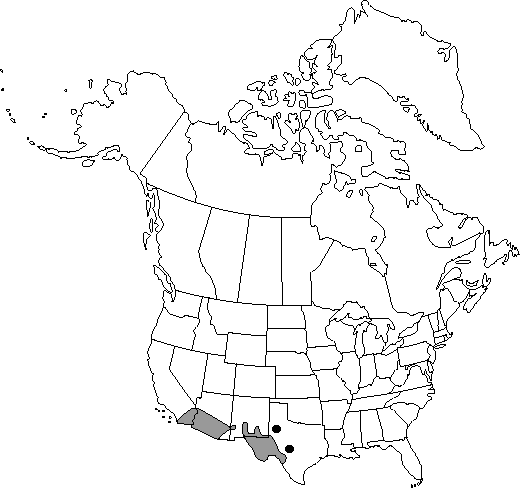Ephedra aspera
Proc. Amer. Acad. Arts 18: 157. 1883.
Shrubs erect, 0.5–1.5 m. Bark gray, cracked and fissured. Branches opposite or whorled, rigid, angle of divergence about 30°. Twigs pale to dark green, becoming yellow with age, not viscid, slightly to strongly scabrous, with numerous longitudinal grooves; internodes 1–6 cm. Terminal buds conic, 1–2 mm, apex obtuse. Leaves opposite (rarely in whorls of 3), 1–3 (–5) mm, connate to 1/2–7/8 their length; bases thickened, brown, shredding with age, ± persistent; apex obtuse. Pollen cones 2 (rarely 1 or whorled) at node, obovoid, 4–7 mm, sessile or rarely on short peduncles; bracts opposite, 6–10 pairs, yellow to redbrown, obovate, 3–4 × 2–3 mm, membranous; bracteoles slightly exceeding bracts; sporangiophores 4–5 mm, 1/2 exserted, with 4–6 sessile to short-stalked (less than 1 mm) microsporangia. Seed-cones usually 2 at node, ovoid, 6–10 mm, sessile or on short, scaly peduncles; bracts opposite, 5–7 pairs, circular, 4–7 × 2–4 mm, membranous, with redbrown thickened center and base, margins entire. Seed 1, ellipsoid, 5–8 × 2–4 mm, light-brown to brown, smooth to slightly scabrous.
Phenology: Coning March–April.
Habitat: Dry rocky slopes, ravines, and fans
Elevation: 500–1800 m
Distribution

Ariz., Calif., N.Mex., Tex., n Mexico
Discussion
Selected References
None.
Lower Taxa
"/2-7/8" is not declared as a valid unit of measurement for this property.